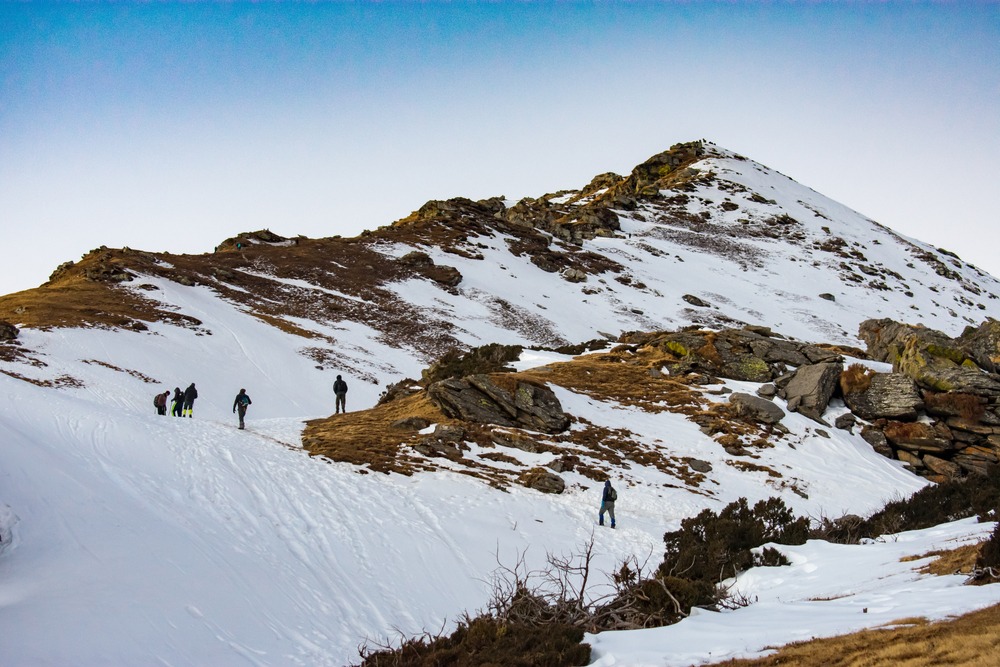If you’re looking for an escape from the daily grind, there’s nothing more rejuvenating than heading into the wilderness, surrounded by nature in its purest form. For me, winter treks are a magical experience. The air feels crisp, the snow makes everything seem fresh and new, and the quiet solitude of the mountains brings a sense of peace that’s hard to find elsewhere. And when it comes to winter treks, Kedarkantha is a destination that I keep coming back to. It’s the perfect winter escape for those who want adventure, beautiful views, and a sense of tranquility that only the mountains can offer.
Kedarkantha is a great trek for all levels of trekkers. Whether you’re new to trekking or a seasoned hiker, this trek gives you the perfect balance of difficulty and reward. The trail is moderately challenging, but it’s not overly strenuous, making it a wonderful winter trekking destination. What makes it so special is that it’s not just about reaching the summit—it’s about the entire journey. From snow-dusted pine forests to alpine meadows, each step offers a new perspective on nature’s beauty, which makes it hard not to fall in love with this trek.
Kedarkantha Trek: A Winter Wonderland Like No Other
Imagine trekking through a winter wonderland where everything is blanketed in snow—this is exactly what you get on the Kedarkantha trek. The entire landscape transforms in winter, with towering trees and mountain peaks covered in a pristine layer of snow. The trek takes you through thick pine forests, open meadows, and stunning ridges where you can catch your breath while taking in jaw-dropping views of the snow-covered Kedarkantha Peak and Swargarohini mountains. It’s one of those places that makes you stop and appreciate the stillness of nature.
One of the things that makes this trek feel so special is the snow itself. As you move through the forest, the trees are covered in thick snow, and the ground beneath your feet crunches with each step. It’s peaceful and quiet, almost too perfect to be real. And when the sun rises over the mountains, the whole world seems to glow in soft golden light, creating a magical atmosphere. The entire trek feels like stepping into a dream, where you’re surrounded by a tranquil landscape untouched by time.
When’s the Best Time to Trek Kedarkantha? Winter, Of Course!
When I first decided to do the Kedarkantha trek, I asked myself, “When is the best time to go?” The simple answer is winter—specifically from December to February. This is when the region is covered in snow, and the conditions are perfect for a winter trek. There’s something absolutely magical about the winter season here. The air is cold and crisp, the sky is mostly clear, and the snow enhances the natural beauty of the landscape, giving everything a fresh, untouched look. I highly recommend The Searching Souls for the Kedarkantha Trek. Their team is skilled in leading trekkers of all levels, and they go above and beyond to provide excellent service, from safe, reliable transportation to tasty meals on the trail.
Winter brings its challenges, of course. The temperatures can drop below freezing, especially at higher altitudes, so you need to be prepared for the cold. But there’s also something incredibly rewarding about being in the mountains during winter. The snow-covered peaks and frozen lakes create an atmosphere that is hard to describe. It’s a quieter time to visit, as fewer trekkers are around, which means more space and solitude for you. Plus, when you summit Kedarkantha, the view is even more spectacular with snow-capped peaks stretching for miles in every direction.
Getting to Kedarkantha: A Journey Worth Taking
The journey to Kedarkantha is half the adventure itself! From Dehradun, the gateway to the trek, you begin a scenic drive towards Sankri, the base camp. The route to Sankri meanders through picturesque villages, thick forests, and picturesque scenery. While it can take up to 7-8 hours by taxi, the journey is a beautiful introduction to the trek. Along the way, you’ll see small, tucked-away villages that seem untouched by time. The winding roads, with views of snow-covered mountains in the distance, make the drive feel like a prelude to the adventure ahead.
While private taxis are the most comfortable way to reach Sankri, shared taxis or buses are more affordable options. The public transport options are a bit more cramped and less predictable, but they can add to the adventure. It’s worth noting that the road conditions can be tricky during the winter, especially with snow and ice. If you’re going during peak winter months, it’s a good idea to make sure your vehicle is well-equipped for snowy conditions. The drive itself, whether you’re traveling privately or through public transport, offers glimpses of the beauty to come—and it’s one of the best ways to prepare mentally for the trek ahead.
A Day-by-Day Breakdown of the Kedarkantha Trek
Let me walk you through a typical itinerary for the Kedarkantha trek. Over the course of five days, you’ll experience the magic of winter trekking in the Himalayas, and I can assure you every moment will be worth it.
Day 1: From Sankri to Juda Ka Talab – The Journey Begins
The excitement begins as soon as you leave Sankri for Juda Ka Talab, a serene lake nestled in the forest. The first day of the trek is all about easing into the journey. At around 4-5 kilometers, it’s an easy-to-moderate walk, but it gives you the chance to adjust to the altitude and pace yourself for the more challenging days ahead. The hike to Juda Ka Talab offers a peaceful atmosphere with pine trees and open meadows, all covered in snow.
As you trek through dense forests, you’ll notice the beauty of nature changing with every step. There’s something about the quiet and stillness of winter that makes the forest feel even more peaceful. Arriving at the lake feels like stepping into a fairy tale. The clear waters of Juda Ka Talab reflect the surrounding snow-covered landscape, and the campsite here is surrounded by tall pines and snow. It’s the perfect spot to rest and settle in for the night under the open sky. As night falls, the cold air sets in, but there’s nothing more comforting than the warmth of a campfire and the camaraderie of fellow trekkers.
Day 2: Juda Ka Talab to Kedarkantha Base Camp – Snow at Every Turn
Day 2 is where the trek starts to get more exhilarating. From Juda Ka Talab, we head to Kedarkantha Base Camp, which is a little over 4 kilometers away. Although the ascent is more gradual than the peak, the challenge is increased by the steeper and snowier terrain. The landscape continues to evolve, offering even more stunning views of the snow-dusted trees and distant mountain peaks. Every now and then, the trail opens up to reveal expansive views of the valley below, which makes the effort of trekking feel worth it.
One of my favorite moments of the trek happened on Day 2. The forest cleared up and the path led us to a high ridge. From here, we could see the towering Kedarkantha Peak in the distance, shimmering in the winter sunlight. The temperature was getting colder as we gained altitude, but the excitement kept us warm. It was truly an achievement to arrive at the Base Camp, and the vistas were stunning. This was also a time to reflect on the journey so far and get ready for the challenging final push to the summit on Day 3.
Day 3: The Final Push to Kedarkantha Summit
Day 3 is the highlight of the trek. Waking up early, we set out for the summit of Kedarkantha—the crown jewel of the trek. Depending on your pace, the roughly 6-kilometer ascent takes four to five hours. The higher we climbed, the steeper the incline, and the more the snow covered the path. But as we neared the summit, the views kept getting more and more spectacular. The surrounding peaks of Swargarohini and other mountain ranges were bathed in golden light, making every step toward the summit feel worth the effort.
It was a moment of sheer joy to stand atop Kedarkantha Peak. The views from the summit are unparalleled, with snow-covered mountains stretching far and wide in every direction. The sense of achievement is immense. After soaking in the views and celebrating our success, we began the descent back to Base Camp. The descent was easier, but there’s something deeply fulfilling about completing such a challenging climb, knowing you’ve reached one of the most iconic peaks in the region.
Why Kedarkantha Trek Is Ideal for Winter Trekkers
Kedarkantha offers the ideal winter trekking experience for anyone who wants to enjoy the Himalayas without the extreme difficulty of higher altitude treks. The moderate difficulty level, combined with the beauty of snow-covered forests and peaks, makes it a perfect choice for beginners and experienced trekkers alike. The snowy landscape adds an extra layer of excitement, and the trekking conditions in winter are just right for those seeking a challenge without too much technical difficulty.
If you’re looking for a trek that gives you the satisfaction of conquering a peak but doesn’t require months of preparation, Kedarkantha is the perfect option. It’s not just about the trek itself; it’s about immersing yourself in the winter experience—camping under the stars, trekking through untouched snow, and finally summiting a Himalayan peak. For me, this was the perfect winter adventure, and I’m sure it will be for you too.
Conclusion: A Winter Trek You’ll Never Forget
Kedarkantha is a trek that stays with you long after you’ve completed it. The pristine beauty of the snow-covered landscape, the challenges of the journey, and the camaraderie of fellow trekkers all combine to make this one of the best winter escapes in India. Whether you’re a beginner or an experienced trekker, it offers the perfect mix of adventure, nature, and tranquility. The Kedarkantha journey need to be at the top of your list if you’re considering spending the winter in the mountains. It’s an experience you won’t soon forget, not just a hike.
FAQs
-
Is Kedarkantha Trek suitable for beginners? Yes, Kedarkantha is often recommended for beginners, especially those with a basic fitness level. The trek is moderately challenging, but it’s well within the reach of most people who are prepared for a few days of hiking in the snow.
-
When is the ideal time to Kedarkantha trek? The best time for the Kedarkantha trek is during the winter months from December to February. This is when the region is covered in snow, making for the best winter trekking experience.
-
How difficult is the Kedarkantha trek? It’s a moderate trek with gradual ascents, but it’s challenging enough to feel like an accomplishment. The weather conditions can make it tough, especially at higher altitudes, but it’s doable for anyone with a reasonable level of fitness.
-
Do I need to be an experienced trekker to do the Kedarkantha trek? No, you don’t need prior experience. A basic level of fitness is enough, and you’ll be supported by guides and fellow trekkers throughout the journey. It’s a great trek for first-timers.
-
What should I carry for the Kedarkantha trek in winter? For a winter trek like this, you’ll need warm clothes, waterproof trekking boots, a good-quality sleeping bag, trekking poles, and plenty of snacks and water. Be sure you’re ready for really low temperatures.



